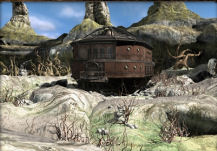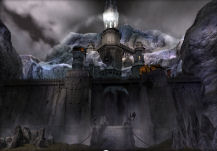Opening:
The
worlds of the clans, the Tetrahedron and the Sacred Rings which control it
all return in The Sacred Rings -- Streko-Graphic’s sequel to
Aura: Fate of the Ages.
Here we travel once again to the magical worlds of the Keepers. Is it
necessary to play
Aura
in order to understand this new adventure? No, not really, but it helps.
Aura gives the gamer the correct mind-set for understanding the
puzzles in The
Sacred Rings,
and also sets up the story. However, this sequel’s own tale is well
developed and it can be played nicely as a standalone game.
Once
again we play the part of a young man named Umang, from the Keeper’s Clan.
The Keepers are a race of beings so far advanced that they can create
imaginative worlds using the technology of the Sacred Rings. The Rings are
four concentric circles which operate much like a gyroscope -- the power
from within them rages and focuses in strength, finally creating a portal
to the worlds they have created. I will tell you now: the worlds are
creative, stunning and include many characters with which to interact.
The Story
At the end of
Aura: Fate of
the Ages
we watched Umang disappear into the portal just as Durad and his hoard
came forth into the Keepers' world.
The Sacred Rings
picks up the story at this point. We see that Bargul and his evil magician
Gugon are the ones who are really behind this unfriendly takeover. Durad
is only a “puppet” for their heinous plans. Bargul tells his henchmen to
find the tetrahedron that Umang has in his possession. “Do what you want
with the boy, but bring the artifacts to me!” It is his intention to enter
the world into which the Keepers have managed to escape. And we now
realize that Umang has once again become the hunted.
Umang lands on the
other side of the portal, alone in a dark and unforgiving world. It is a
world which seems to exist hundreds of years after the reign of the
Keepers. An odd little man notices Umang's appearance outside his strange
house and goes out to investigate. His name is Nikafor, and he brings the
unconscious Umang inside to rest. Umang awakens and begins a friendship
with Nikafor. It is here that our quest begins.
The
Look and Feel
The graphics are beautifully rendered. Each world that
Umang visits displays a distinct visual flavor. I particularly enjoyed
their varying color palettes -- from the crystalline clarity of the
Alchemist world, and the somber and foreboding atmosphere of the Cemetery,
to the verdant lushness of Nafal's World. The 360 degree panning fosters a sense
of immediate immersion. Though the backgrounds and scenery are lovely to
view, some of the characters we interact with still seem a tad wooden
during the cut scenes. However, the voice work does make up for their lack
of animation -- Umang's in particular. I felt his dialogue, as well as
that of Nikafor, was particularly entertaining. This leads me to the
ambient sounds and underscore, which complemented the storyline quite
well. I love good music in adventure games, and I must say that
The Sacred
Rings
does not disappoint. I heard at least eight different themes as I
traversed the game’s universe. Each one worked wonderfully with the
atmosphere that the developers were trying to evoke.
Game Play
This is a point and
click first person adventure with many (and I do mean many) interesting
and mysterious places to discover and explore. I found the installation to
be easy, though time-consuming, with four CDs involved in the process. The
game plays from the hard drive and a CD does not need to be in the drive.
There were no glitches. A point in the game's favor is the short
introduction, containing two cut scenes comprising a succinct synopsis of
Aura: Fate of
the Ages.
Afterwards, one returns to the Main Menu to begin the adventure. Besides
the normal Save, Load, Options and Exit buttons in this Menu, I liked
seeing a Video section where one could view the cut scenes already shown.
The interface is very easy to use. The ESC key will bring up the Main Menu
-- while the first two videos will play at the beginning of each gaming
session, hitting the space bar will get you back to the Main Menu.
The game appears to
be divided into chapters, apparently to separate the strange worlds and
environments that Umang must visit. The puzzles and tasks are
fascinatingly clever and grow nicely from the storyline. A right click
will bring up the inventory, which is located at the bottom of the screen.
Umang's notebook or journal, which holds many important clues, is located
on the right. Both the inventory and the journal are simple to use. Many
of the puzzles are mechanical; some are inventory based and others are
color based. Some are interesting number puzzles (my personal favorite was
the candle puzzle at the Mausoleum in the Cemetery world and the “Tower of
Hanoi” in reverse in the stormy world of Reina). There are a few paths
that Umang will need to tread which are quite maze-like, and one wicked
doorway puzzle in Reina which was hysterical.
There aren’t any
action or timed sequences within
The Sacred Rings.
However there are a number of “stealth” scenarios where you must be very
careful not to get caught. If you listen to what Umang is thinking you can
avoid some precarious situations. Still, you can be either captured or die
in this game -- but restarting is easy from a previous save. In an adventure
such as this, it would be nice to have an unlimited save structure instead
of the eight slots allowed for the game. However, this can be worked
around by copying the saved game folder in its entirety and then pasting
it into a separately created folder for safekeeping, then writing over the
original saves. I managed to create over forty-eight saves this way.
Now I won’t go into
the endings here. There are a number of them. The main one was quite
satisfying…but the alternatives left me cold; they gave the impression
that the developers just ran out of steam. While the idea of multiple
endings is commendable, my humble opinion is that alternative endings
should be either fully executed, or left as wishful thinking on the
cutting room floor.
Conclusion
Even with the above
criticisms, I had a great time playing this game and was immersed from the
start. Did I enjoy this adventure better than the original? That is
difficult for me to answer, for I thoroughly enjoyed the former and
appreciated the latter for its continuation of the storyline. It is
evident that Streko has indeed worked hard to improve their saga and
increase its “adventure value.” Would I recommend playing
The Sacred Rings?
Absolutely. The beautifully detailed graphics, atmospheric music,
absorbing puzzles, dozens of cut scenes and fascinating story all work
together to make what is, for the most part, a lovely and intriguing
experience.
…inferno
Grade B
Recommended System Requirements:
OS:
Windows2000/XP
CPU: 1.6
GHz Intel Pentium III or AMD Athlon Processor
RAM:
512MB
Disk
Space: 3.5GB
CD/DVD-ROM: 16x or higher DVD ROM Drive
Video:
64MB 3D Accelerated Video Card
(DirextX
9.c Compatible)
Sound:
DirectX 8.0 Compatible
Input:
Keyboard and mouse
Minimum System Requirements:
OS:
Windows2000/XP
CPU: 1.2
GHz Intel Pentium III or AMD Athlon Processor
RAM:
128MB
Disk
Space: 3.5GB
CD/DVD-ROM: 16x or DVD ROM Drive
Video:
64MB 3D Accelerated Video Card
(DirextX
8.1Compatible)
Sound:
DirectX 8.0 Compatible
Input:
Keyboard and mouse
Played on:
OS: Microsoft Windows XP Home
SP 2
CPU: Pentium D 950 3.4GHz
800MHz
RAM: 2GB DDR2
Video: BFG nVidia Geforce
7600GT OC 256MB 128bit
Sound: SoundBlaster Audigy
DVD ROM: DVD-ROM DVD-1S16P 16x
Monitor: Northgate 20' Flat
Panel Monitor
DirectX Version: 9.0c
May 2007
design copyright ©
2007
GameBoomers
Group



